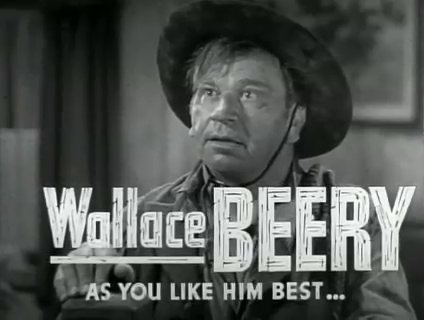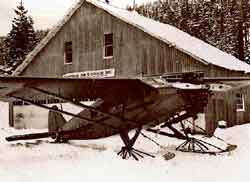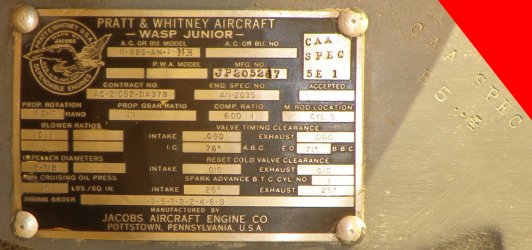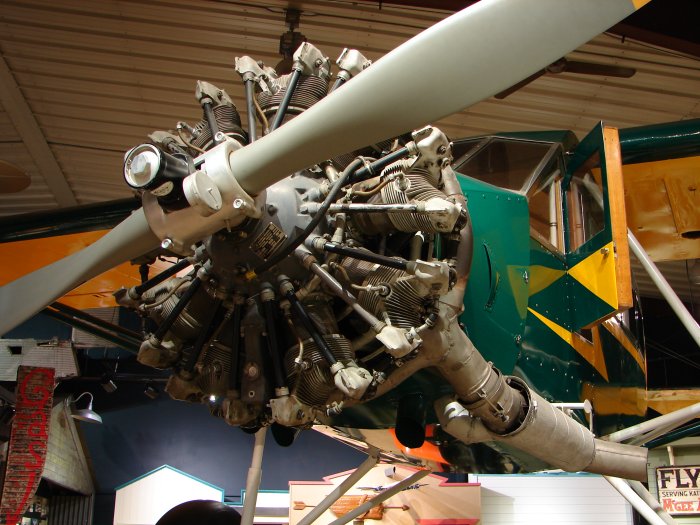1929 Travelair 6000B NC8159
About 150 aircraft built.
It was developed as a luxury version of the Travel Air 5000 marketed
principally as an executive aircraft, although its size proved popular
with regional airlines. The fully-enclosed cabin was insulated and
soundproofed, and included wind-down windows.
Look at the flat windshield. In 1906 the Safety Motor Screen Co. was
created in England. In the Road Traffic Act of 1930, the British
parliament required new cars to use windscreens of “safety glass”.
In 1933, the brand name “Plexiglas” was patented and registered by a
German chemist. In 1936 Imperial Chemical Industries (now Lucite
International) began the first commercially viable production of
acrylic safety glass.
It has a Pratt & Whitney R-985-AN-14 450 HP engine and cruised at 110 mph for about 550
miles with 5 passengers in some comfort.
The AAM Travel Air came to Alaska in 1939 with “Mudhole” Smith’s
Cordova Air Service and later belonged to Peck and Rice Airways in
Bethel. A number of pioneer aviators owned NC8159 including Albert
Ball, Fred Goff and Al Jones.
(Wikipedia) - Travel Air 6000
Travelair 6000B
| Crew: |
1 pilot |
| Passengers: |
5 |
| Length: |
30 ft 10 in |
9.4 m |
| Wingspan: |
48 ft 7 in |
14.81 m |
| Wing area: |
282 sq ft |
26.2 sq m |
| Empty Weight: |
2,608 lb |
1,183 kg |
| Gross weight: |
4,230 lb |
1,919 kg |
| Powerplant: |
Pratt & Whitney R-985 |
| |
450 hp |
335.5 kW |
| Performance |
| Max Speed: |
130 mph |
209 km/h |
| Range: |
550 miles |
885 km |
| Ceiling: |
16,000 ft |
4,880 m |
| Rate of climb: |
800 ft/min |
4.1 m/s |
The Travel Air 6000 (later known as the Curtiss-Wright 6B when Travel
Air was purchased by Curtiss-Wright) was a six-seat utility aircraft
manufactured in the United States in the late 1920s.
It was developed as a luxury version of the Travel Air 5000 marketed
principally as an executive aircraft, although its size proved popular
with regional airlines, which purchased most of the roughly 150
machines built.
The 6000 was a high-wing braced monoplane with a fuselage constructed
of steel tube and covered in fabric. In keeping with its intended
luxury market, the fully-enclosed cabin was insulated and
soundproofed, and included wind-down windows. The basic model was
priced at $12,000, but numerous options were offered that could nearly
double that price; actor Wallace Beery’s aircraft cost him $20,000 and
was the most expensive Model 6000 built.
Travel Air
A-6000-A NC9015
In 1928 he bought Travel Air NC9015, which he brought to Tucson. This second purchase was surrounded by press coverage: The New York Times of December 9, 1928 reported that his purchase was, “...a monoplane type, built to carry five passengers, two pilots and ‘breakfast-room equipment’”. The airplane was further described by the Newark Star-Eagle of 12/24/28 as, “A two-ton limousine of the air, luxuriously appointed....It has a small wash room and many other conveniences found in a railroad coach.”
Wallace Beery - Starred in “The Champ”, released on Nov 9, 1931. At the 5th Academy Awards on Nov 18, 1932, he won the Academy Award for Best Actor.
His contract with Metro-Goldwyn-Mayer stipulated in 1932 that he
would be paid $1 more than any other contract player at the studio,
making him the highest paid actor in the world.

Wallace Beery -
Davis-Monthan Aviation Field Register
In the January 1931 issue of ‘US Air Services’ Boeing ran an ad that mentioned “elevating windows and windshield, non-shatterable glass”

According to (Wikipedia) - Travel Air 6000, A Travel Air 6000 was a "star" in the Howard Hawks 1939 film ‘Only Angels Have Wings’ which was a fictional depiction of the early mail service in South America whose early days mirrored the aircraft and issues of US civilian mail service. The AAM Metalplane H-45 NC7791 is in this movie also.
N8159 TRAVEL AIR S6000 B S /N 967
N8159 was built by the Travel Air Corp. in Wichita KS in February
1929. The company president at that time was Clyde Cessna ,the general
manager was Walter A. Beech and the design engineer was Lloyd
Stearman. The following is a chronological history of this aircraft,
from the day it was first sold until it was purchased by The Alaska
Historical Aviation Museum.
2 March 1929 - Date of manufacture.
5 March 1929 - Sold to Texas Air Transport Flying Service of Fort
Worth, TX. The purchase price was $13,000. This bill of sale was
signed by Walter A. Beech for the Travel Air Company. The application
for Identification Mark (N number) showed C.R. Smith as
secretary-treasurer of Texas Air Transport Flying Service, which
evolved into American Airlines with C.R. Smith as President and CEO.
5 March 1929 - Application for identification mark completed by Texas
Air Transport Flying Service.
23 March 1929 - 8159 assigned as Identification Mark by U.S. Dept. of
Commerce.
28 March 1929 - Application for an Airplane License, (see next entry),
submitted to the Dept. of Commerce. This document listed February 1929
as the date of manufacture. It stated that the aircraft would only be
flown by licensed pilots and would be operated over a fixed route--Ft.
Worth--Houston--San Antonio. The equipment list showed no seat belts
installed.
15 April 1929 - Commercial license issued. The various licenses that
were issued when this aircraft was new were comparable to the
Airworthiness Certificates used today.. The identification number
would change depending on what license was in effect at the time;
example, 8159 or C8159 or NC8159 or R8159. Only licensed pilots could
legally fly aircraft with a letter prefix. If the number had no letter
prefix, as in 8159, then it was limited to commercial operation wholly
within one state and licensed pilots were specifically prohibited from
flying an aircraft without a letter prefix while carrying persons or
property for hire. The letter prefix designated the category the
aircraft could be operated in. Several times during the 30’s and 40’s
8159 had an R prefix, as in R8159, because it was used for
photography. C and NC were commercial licenses, R and NR were
restricted licenses and X and NX were experimental licenses. These
licenses were issued semi-annually.
6 July 1929 - Accident at Grand Island LA broke left undercarriage
(landing gear) and bent the motor mount, possibly a ground loop.
12 December 1929 - Application was made for a Restricted license for
photographic work.
15 December 1929 - Special airplane license issued restricting the
aircraft to photographic work, the Identification Number became
NR8159.
1 April 1930 - Commercial licenses reissued using a new form, this
form stated the category as “Commercial” and the identification number
became NC8159.
3 September 1932 - Ownership transferred from Texas Air/Southwest Air
Transport to American Airways Inc. of St. Louis MO, C.R. Smith
President.
5 October 1932 - Sold to Northland Aviation Co. Minneapolis MN.
7 October 1933 - Major overhaul completed, including replacing the
windshield with non-shatterable glass, new tires, recovered ailerons,
rebuilt elevators with new ribs and fabric, repaired rudder, replaced
aileron elevator and rudder cables and overhauled engine.
6 December 1934 - Sold to Northwestern National Bank, Minneapolis MN.
10 December 1934 - Sold to Ellen Nisun, Minneapolis MN.
2 January 1935 - Both wings recovered.
4 January 1935 - Letter from Curtiss Wright Airplane Co. to Mr.
Kenneth Nisun listed changes need to upgrade to a seven place
airplane. This letter quoted him a price of $45.00 for a new chair,
upholstered in red leather, this was probably how the other seats were
upholstered.
29 January 1935 - In a letter to the Bureau of Air Commerce in Chicago
IL, the Bureau in Minneapolis, asked if it were possible to licenses
an airplane in two categories, the inspector had never been confronted
with a request like this before, the only action necessary to change
categories would be to remove the dual controls when carrying six
passengers. This query was forwarded to Washington Engineering for
advice. This request was approved 18 February 1936, however there were
conditions attached and it took six more pieces of paper before final
approval.
6 October 1935 - Sold to Viola Mary Buskey, Minneapolis, MN.
30 March 1937 - Sold to Mel Swanson, Minneapolis, MN.
7 September 1937 - Sold to Freeman Aircraft Sales, Minneapolis, MN.
25 October 1937 - Sold to Edna M. Enders, Minneapolis, MN
2 July 1938 - Sold to Harold E. Clark, Minneapolis, MN.
15 August 1938 - Sold to DePonti Aviation Co., Minneapolis, MN.
24 October 1938 - Sold to John M. Peterson, Peterson Flying Service ,
Boeing Field , Seattle, WA.
12 April 1939 - Engine overhaul cost $280.21, materials to refinish
fuselage fabric cost $21.27.
28 April 1939 - Approval for first radio instalation requested. The
installation consisted of transmitter, receiver, inverter and trailing
wire antenna, and weighed 36.5 lbs.
1 August 1939 - Sold to Cordova Air Service, Cordova, Territory of
Alaska. Merle K. Smith, known
as “Mud Hole”, President. The purchase
price was $3,500.00.
24 August 1939 - Commercial license application listed the total time,
after ten years of service, as 1753.5.
25 November 1939 - Skis installed for the first time.
1 April 1940 - Extensive repairs after accident on 25 February 1940,
included the motor mount, rear fuselage structure, ribs in left wing
and replacement of propeller.
26 February 1941 - Extensive repairs required after accident on 31
October 1940.
22 September 1944 - Sold to Peck and Rice Airways, Anchorage,
Territory of Alaska.
23 December 1944 - Sold to Mrs. Al Jones (Anne Bruington Jones),
Bethel, Territory of Alaska. Mrs. Jones paid $6,000 for NC8159 and
NC8713. She was originally from Alvin TX and was born, 18 February
1900.
1 June 1945 - Major repairs were completed, which included overhauling
the engine, recovering the fuselage, replacing the right wing (with
one from Travel Air S/N 6284) and installing an overhauled propeller.
25 April 1946 - The payoff of the mortgage is acknowledged by E.E.
Rasmuson President of the National Bank Of Alaska. His signature
appears several times in the records of this aircraft.
18 September 1946 - Major repairs were completed which included
replacing all of the landing gear fittings, the landing gear,
windshield, propeller and the engine. The work was done by Jack Carr
of Anchorage.
20 September 1946 - Sold to Toivo Alfred Aho and Dallas Leroy Bowen,
Anchorage, Territory of Alaska.
23 January 1948 - Major repairs were completed which included
replacing all gear fittings, realigning the fusalage and fabricating a
new motor mount. This motor mount made it possible to install a P/W
R-985, 450 hp engine. This was accomplished by Pacific Airmotive at
Merrill Field, Anchorage. The original engine was a Wright J-6, with
300 hp, this was later upgraded to a Wright R-975 with 330 hp.
13 June 1947 - Pratt & Whitney R-985-An-3 engine installed. The
operation limitations issued by the Civil Aeronautics Administration
stated that this aircraft was limited to operations within the
Territory of Alaska. For approval elsewhere additional flight tests
would be necessary to determine adequacy of oil inlet temperatures.
9 April 1948 - Both wings and ailerons were rebuilt, the damage was
possibly caused by high winds.
1 June 1948 - Installed Edo J-5300 floats; this appears to be the
first installation of floats on the aircraft
24 January 1949 - Sold to Albert Ball and Myron Moran, Dillingham,
Territory of Alaska.
24 June 1949 - Recovered fuselage and empennage.
6 April 1951 - Repaired extensive damage, this was possibly caused by
high winds, this repair did not involve the landing gear nor the
engine and propeller. The form ACA 305a, AIRCRAFT INSPECTION REPORT,
dated 6 April 1951, contained the following statement written by the
CAA Aviation Safety Agent. “This particular plane and engine
combination is not listed in the Aircraft listing, nor do I have a
Specification sheet covering it. However it was originally licensed in
Anchorage by the C.A.C. Engineering representative Clark Marks and
Aviation Safety Agent Chas. Knobler.”
12 February 1953 - Sold to Western Alaska Airlines, Dillingham,
Territory of Alaska, the Treasurer is listed as Albert Ball. This is
when Western Alaska Airlines was formed.
5 October 1959 - Sold to Maurice E. Goff, Spenard AK
21 September 1959 - Replaced right aileron, repaired left aileron and
left wing spar, no cause for damage given.
15 May 1961 - Overhaul accomplished including, recovering the fuselage
and empennage with grade A fabric. Both lift struts were replaced with
larger diameter tubing.
10 May 1963 - Both wings and ailerons were overhauled and recovered
with Irish linen.
25 March 1976 - Sold to William and Nancy Magnuson, Anchorage AK
2 December 1991 - Sold to Alaska Aviation Heritage Museum.
2 April 1997 - The overhaul and complete recovering of the aircraft
was completed by the staff and volunteers of the Alaska Aviation
Heritage museum.
Present - N8159 is presently on display at the museum. N8159 is
airworthy and could possibly be flown again.
N8159 has had a long and colorful career. It has been owned and
operated by many famous and infamous pilots and airlines. It has been
in many accidents and incidents and has carried hundreds of people and
tons of cargo safely to their destinations. It is one of the finest
examples of the aircraft that carried the United States into, what is
referred to as, the Golden age of aviation.
Aero Digest - February, 1930
PROFITABLE LINKS in Air Transportation
THERE is one sure way to gain better than usual
profits from air transportation. Put your business
on a basis of safety, speed and comfort at low operating
cost — with TRAVEL AIR Six-place Cabin Monoplanes !
Throughout America there is a need for tributary air
lines, to fill in the gaps between ofF-main-line cities and
important airports on cross-continent routes. Passengers
will patronize a feeder line that takes them direct to a
connecting airport without the delay of transfer from
train or motor bus, and long-distance travellers like to
continue their journey by air from division point to
destination. Such air travel truly saves time.
See Travel Air in the Curtiss - Wright Exhibit
at the International Aircraft Exposition,
St. Louis
February 15th to 23rd.
Passenger confidence is won and held by TRAVEL
AIR. Its luxurious interior
provides comfort and relaxation — riding pleasure
that makes boosters and brings repeat business.
From the operator's angle, TRAVEL AIR six
place Cabin Monoplane is an ideal ship. It is extremely versatile — in local
line passenger and express service, in charter for business
or pleasure trips, or as a reliable means of transportation for emergency when speed is especially important.
On every good point you can think of — handsome appearance — inherent safety — easy handling — all-weather
efficiency — speed that assures low passenger-mile costs —
TRAVEL AIR has demonstrated its superiority.
Write straight to headquarters for full information on
TRAVEL AIR monoplanes for transport service and detailed
statements of costs in actual operation.
Address Dept. T-70
TRAVEL AIR COMPANY
Division of CURTISS - WRIGHT
Sales Offices: 27 West 57th Street, New York
A PLANE FOR EVERY PURPOSE
Say you saw it in AERO DIGEST
FEBRUARY, 1930




